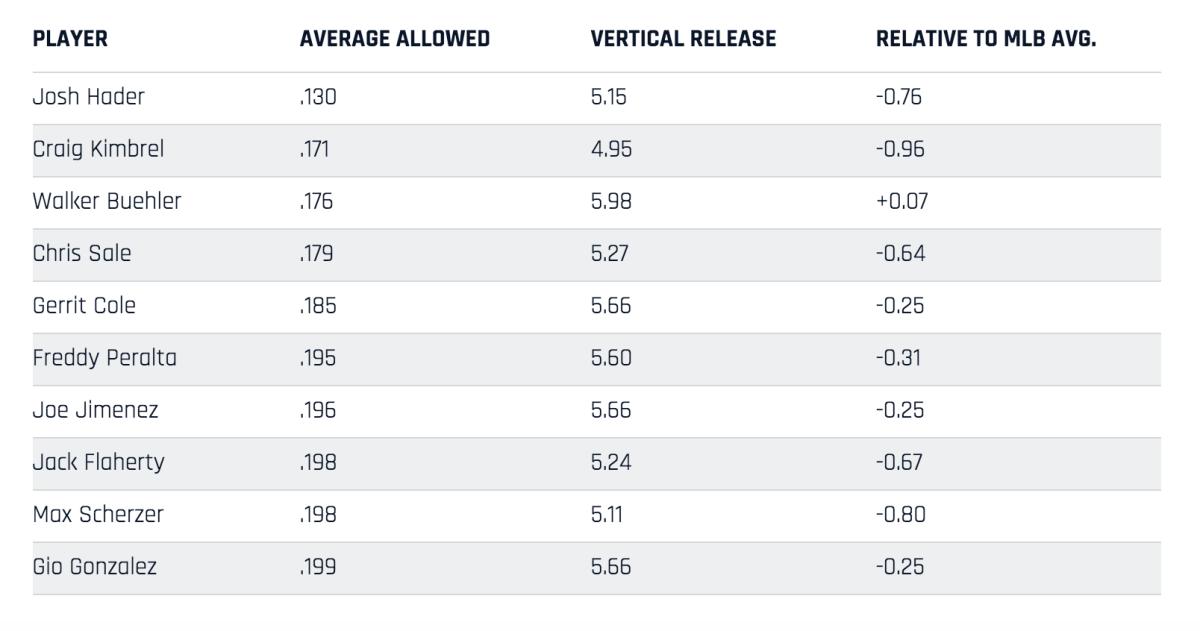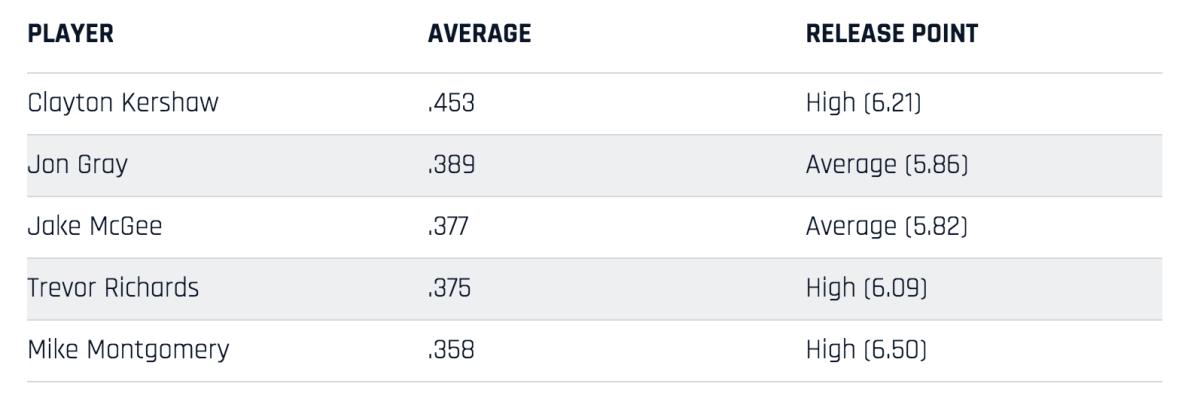Free Agent Craig Kimbrel Is Perfectly Suited to Defeat Baseball's Modern Hitters

Three months into the free agent market, the biggest surprise is that not only has no team signed the toughest pitcher to hit in baseball history, but also that the buzz around reliever Craig Kimbrel is minimal. Perhaps Kimbrel scared clubs in the early going with rumors of a $100 million asking price.
But here’s what teams should know about Kimbrel: because of the way he throws, there is no pitcher better equipped to continue to defeat modern hitters.
Firstly, though Kimbrel throws his fastball 97 mph, he features a wicked power curveball. Despite all the noise and excitement about velocity, the biggest reason why hits are harder to come by in the majors since 1972 is spin, not velocity. (More on that another time.)
Secondly, Kimbrel throws with a release point (just 4.95 feet off the ground) that is almost a foot lower than the major league average for a four-seam fastball (5.91).
Creating a Trade for Madison Bumgarner
Why is that an advantage? Because as hitting changed to prioritize slugging over contact—the Launch Angle Revolution emphasizes getting the ball in the air—some of the tenets of great pitching as we used to know them no longer apply.
Keep your fastball down.
Get on top of the ball.
Get your elbow up.
Create a downward plane with your fastball.
Forget them—or at least don’t accept them at face value anymore.
The way Kimbrel throws a baseball inspired me to study the correlation between release point and fastball effectiveness. It turns out Kimbrel should not be viewed as an anomaly. He is the template for the best way to combat the Launch Angle Revolution.
The quick answer from the data is this: a lower release point is more effective than a higher release point, and it’s not even close. The key currency to major league fastballs is not miles per hour, but “run,” and that’s where the low release point plays well.
Let’s start with Kimbrel, and how historically great he is at defeating hitters:
Lowest Career Batting Average Allowed (Min. 500 games)

(Aroldis Chapman is 10 games short of qualifying for this list, but even he, at .158, is not quite Kimbrel.)
Through their age-30 seasons, Kimbrel has more saves than Mariano Rivera (333 to 245), a much lower ERA (1.91 to 2.63) and a much better adjusted ERA (211 to 180). I’d still trust Rivera more in a big spot, but I use those comparisons to help you understand the incredible career for Kimbrel when it comes to dominating hitters.
Now take a look at where Kimbrel releases the ball. Note that his shoulders are flat—not tilted with arm side higher—and the baseball is below the height of the top of his cap.

The height of his release point is what confuses hitters. Hitters subconsciously use a mental process known as “chunking.” Because it is impossible for their eyes to follow the baseball all the way to the point of contact (it’s moving too quickly and too close), they swing the bat to get the barrel at a point in space where they think the pitch will be just as it nears the plate. They do that based on reading spin and velocity. But they also use the “chunking” method: from having tracked thousands of pitches out of pitchers’ hands they form an idea—as in gathering all that experience into a “chunk”—of the expected path of the pitch.
Major league hitters mostly see pitches that leave a pitcher’s hand about six feet off the ground. But from Kimbrel they see the baseball coming from a spot a foot lower—such an outlier spot that it defeats the “chunking” process.
BACCELLIERI: Grandal's One-Year Deal Proves Free Agency Is Broken
Watch when Kimbrel gets swings and misses on his fastball. In almost all cases the hitter’s bat passes under the pitch. That’s because the ball is not as low as what the hitter’s “chunking” process told him where it would be—and that’s because of his low release point. Kimbrel’s low angle generates more “run” than it does “tilt.”
It would be easy to think Kimbrel simply benefits from having great stuff, especially for a guy who throws so hard. So I looked at the 10 toughest four-seam fastball pitchers in the game and wondered if there was any correlation with release point. It turned out the correlation is exceedingly strong: 90% of the toughest four-seam fastballs are thrown with a release point lower than average, and by at least three inches:
Lowest Batting Average vs. Four-Seam Fastball (Min. 150 Results)

You can find many more examples of low-release point power pitchers who fell just out of the top 10: Aaron Nola, Jacob deGrom, Corey Kluber, Edwin Diaz, Seranthony Dominguez, Trevor Bauer, Kyle Freeland, etc.
The next step was to study every pitcher who threw a four-seam fastball last year to see if release point meant anything to the entire universe of pitchers. Once again, the correlation was undeniable:
Four-Seam Fastball Results by Vertical Release Point, MLB 2018

In today’s game it is a clear advantage to throw a fastball lower to the ground than the traditional “get on top of the ball” high release point. And that’s because the modern swing is designed for loft—to have the path of the bat (upward) get on the plane of the pitch (downward), especially on a pitch that is low. So the modern swing is poor at matching the plane of a fastball that has more “run” and less downward plane.
“The typical swing path now is basically your back side kind of lowers and you stay on plane,” said Nationals hitting coach Kevin Long. “That’s why sinkerball pitchers who used to be effective are not nearly as effective in today’s game.
New Year's Resolutions for Every MLB Team
“Now it’s the guys who can get their ball to ride who have the advantage. To hit them you have to always think more with your hands than the conventional way of staying connected. If you watch—and there’s so much new data that shows this—guys like Scherzer and deGrom who are almost unconventional, they create a huge advantage against the connected swing. It’s almost like you have to go back to hitting the way it used to be taught—using your hands [to get on top of the ball] and not being as connected.
“You don’t see guys throwing like that that often. And the mechanics of the modern swing are not conducive to hitting that kind of stuff.”
Here is a visual to help you understand what Long is talking about. Take the planes of two fastballs: one thrown from a high release point for a low strike (the traditional plane, shown in blue) and one thrown from a low release point for a high strike (the modern, or Kimbrel plane, shown in red).

At about two-thirds of the way to the plate—the point when a hitter has decided to swing—both pitches are the same height off the ground. The hitter wants to hit the ball in the air and he has “chunked” information to conform to the most common release height, so his swing is tailored to match the plane of the blue pitch. By throwing from a lower release point to a higher target, pitchers like Kimbrel defeat the hitter’s physical and mental training. The pitch on the red plane zips over the barrel of the bat. This is what is referred to as “run”—it’s shorthand for when pitches travel above what hitters determine to be the expected path of the pitch.
It’s easy to measure how much harder it is for hitters to hit a fastball on the red plane (low release point to high strikes) than it is to hit one on the blue plane (high release point to low strikes)—and that difference is staggering:
2018 MLB Batting vs. Four-Seam Fastballs
Based on Pitch Plane
Blue Plane (High to Low): .297 AVG, .492 SLG
Red Plane (Low to High): .212 AVG, .286 SLG
Think of the High to Low pitchers as those using traditional methods in a Launch Angle game. If we look for the worst four-seam fastballs thrown for low strikes, we see only pitchers with average to high release points—with a certain future Hall of Famer and his traditional high overhand delivery “leading” the list:
Worst Four-Seam Fastballs for Low Strikes (Min. 50 results)

No wonder the high-strike four-seam fastball is one of the game’s hottest pitches. Its use is up 18% just since 2015—more than 7,000 in raw numbers. The team that threw the most high heaters last year, the Red Sox, just happened to win the World Series. Meanwhile, the 16 teams who threw the fewest high-strike four-seam fastballs combined for exactly zero postseason wins.
All around baseball teams are hiring young, data-savvy hitting coaches who understand the physics and biomechanics of the swing. Job 1 for them is to figure out the adjustment to the high fastball. The worst teams at the pitch last year were the Mets (.200), Yankees (.207) and Phillies (.221). The best were all playoff teams: the Indians and Astros (.284), the Cubs (.280) and—yes, here they are again—the Red Sox (.278).
“We’re looking into it,” said Cubs manager Joe Maddon, even though his team led the National League. “We’re looking at the axe-handled bat, whether that makes a difference, the position of the hands, everything.”
Let’s close, fittingly, with Kimbrel, and how, as Long said, “unconventional” low-release throwers like Kimbrel are forcing hitters to adapt their swings. The toughest pitcher in baseball history is even tougher to hit when he elevates his fastball. Batters hit just .132 against Kimbrel’s fastball over the past four years when he throws it to the upper third of the strike zone. And when he throws it there with two strikes? Forget it. They hit .080, with nine hits in 112 at-bats.
There can be no doubt that his “unconventional” way of throwing a baseball, not just his velocity, serves him well in today’s game. Here’s what else helps Kimbrel: hitters don’t see his “unconventional” plane nearly often enough to adjust—to create a “chunking” process tailored to Kimbrel.
Kimbrel faced 159 different batters last year. None of them saw him more than five times. Virtually half of them (80 of 159 batters) saw him only once. Think about that: half the batters he faces get one try per year to figure him out.
Kimbrel looked strangely shaky in the postseason last year, in part because of a pitch-tipping problem he corrected in the World Series. But would you consider his free agency based on nine games or nine years? Do the inventory: wicked breaking ball, 97 mph heater, seven All-Star teams, a health history so clean he is the only active pitcher with eight straight years with 45 or more games finished (Kenley Jansen has six; no one else has more than four) … and a pitch plane perfect for thwarting the modern swing.
